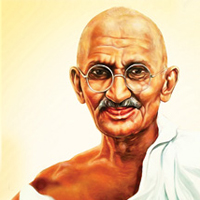Honoring Mahatma Gandhi: South Florida Essay Winners
Recently, Desh-Videsh held an essay competition among Bala Vihar children at the Florida Hindu Mandir in Oakland Park, Florida. The essays were to expand on the philosophies and teachings of Mahamta Gandhi. In honor of Gandhiji’s October 2nd birthday, we are delighted to publish the winning entries.
Students were asked to select one of the three topics noted below and compose an original essay answer to the question. Entrants in the 9-12 age category were requested to write 750-1,000 words, while those in the 13-17 age category were asked to write 1,000-1,500 words.
The topics were:
1. The teachings of Mahatma Gandhi: How does Gandhi’s message of love, tolerance and non-violence apply to our society today?
2. Mahatma Gandhi and Religion: “My Life is my message” What message did Gandhi give to the world?
3. Mahatma Gandhi: A Global Ambassador for Non-Violence: Are Gandhi’s teaching still relevant in today’s Society?
Winners were presented with a cash prize and will also have their essay published in Desh-Videsh.
This month, we congratulate the first-place winners in both age categories.
“My Life is my message: What message did Gandhi give to the world?
By Nina Ali
1st Place Winner, 13-17 Age Category
He is a particular individual you would not forget; a prominent character in society. Some might even call him a hippie. He was devoted; and would never abandon his beliefs no matter what obstacles encountered him. He collected veracity and distributed them to his family. His paramount achievement was perseverance. Everything he has fulfilled was done for a purpose. A vital purpose. His name was Mahatma Gandhi.
Mahatma Gandhi, birth name being Mohandas Karamchand Gandhi, was born in Porbandar under British Indian rule. He is the son of Karamchand (father) and Putlibai (mother) Gandhi. Although he and his father were hindus, his pursuit of peace was influenced by his mother’s religion, Jainism. At the age of thirteen, Gandhi married Kasturbai Makhanji. As they grew, they had four sons together. His patience was often abridged with his wife and children, which caused a weak relationship between them. Gandhi studied to become a barrister in order to rise to his father’s position as the diwan, or high official, of Porbandar, but later gave up this chase to awaken harmony in India.
Gandhi was induced to create non-violence among citizens in India. Many occurrences lead him to act upon this, such as when he dealt with racism while attending law school in London, England. His business trip to Africa was another cause, after refusing to alter from first class to third class on a public train which resulted in prosecution. He engaged in hunger strikes on account of aggression arousing in India to prove that fire cannot fight with fire. Gandhi’s legendary Salt March to the sea was a peaceful protest against the rise in taxes for salt. Him and his supporters originated their own salt in order to express their disapproval.
Inflicting with the truth was often communicated by Gandhi to his fellow friends. He urged people to cope with dilemmas; that the only way it will diminish is by realizing the truth. Everything he advised was veritable and given much thought. Gandhi was also aware to the poverty in India. He stated the fact that until every single human being in India receives a kurta, he would not wear one either. The only garments he wore was a dhoti and a shawl, which he would weave with a charkha, a traditional spinning wheel for turning thread or yarn to make clothing. He did not want to dress more elaborate than the needy citizens of India. With the purpose of that, he decided to dress identical to them. They were his family. The people who he spoke for. He was their voice. Not forgetting the fact that the British ruled and were dominating every part of India. However, Gandhi’s teachings benefitted the path to their independence, which occurred in 1947.
Although Gandhi had a fear of being in the dark due to roaming ghosts, violence was his primary fright. The thought of humans killing humans dismayed him. It was his great malevolence. He taught what he practiced and practiced what he taught about non-aggression. Gandhi’s determination inspired others in India. They were encouraged to follow in his footsteps. His perseverance, with the assistance of his family, stimulated the Salt March and the independence of India.
There were many struggles experienced in his pursuit, however. Not forgetting the numerous arrests he under- went. In 1920 he was arrested for advising Indians to reject all government policies and boycotting their products, but the Britsh were commanded to liberate him. In 1922, the British arrested Gandhi for attempting to defeat the government In the Salt March of 1930, him and about 60,000 supporters were imprisoned for illegally creating salt on the Gulf of Cambay. He was discharged in January of the following year and was available to attend the Round Table Conference in London, but the situation failed and he was back in jail. In 1933 he was released and returned four months later with his wife Kasturbai and thirty followers for the commencement of another civil rights movement. They were sentenced for one year. Finally in 1942, Gandhi was prosecuted by the British officials, who believed that this arrest would prevent any determination of opposition against the “Quit India” Movement. However, due to the death of his wife in 1944, he was permitted to appear at her funeral but was sent back to jail. Then a few months later, he was officially released because of complications in his health.
On January 30, 1948, Gandhi was assassinated by a fellow Hindu nationalist, Nathuram Godse. Godse disagreed with Gandhi’s teachings, believing that he demolished India instead of enhancing it. While Gandhi was approaching a platform in which he was to acknowledge a prayer meeting in Raj Ghat, Godse shot him three times in the chest. There had been previous attempts by others to kill Gandhi as well. Unfortunately this attempt was successful. His final words was “He Ram.” Godse was executed over a year after the death of Gandhi.
Gandhi’s funeral gathering occured at the same place he was assassinated. He was also cremated there. Some of his ashes were distributed across India in urns for memorial services. Some were also cascaded into the Nile River, Girgaum Chowpatty, and a majority of it into the Triveni Sangam.
Mahatma Gandhi will definitely not be forgotten. He put his values and beliefs into his acts, which abided many challenges. However, accomplishes were absolute. His hunger strikes produced amity between rivals, ending their acrimony. Though his dedication to civil rights were practiced through ahimsa, he faced derogatory and racist acts, including multiple arrests, which were a positive impact and inspiration to India’s citizens, even though they were some times imprisoned in their effort. His actions emanated predominant successes, such as the independence of India, that was benefitted by his determination. He used his confidence as the voice of his family, which he considered as all of India. He was one who did not desire prosperity. In fact, living in the realms of poverty was his luxury. Gandhi is a common role model for people in every country on this planet. Well-known pacifists, such as Martin Luther King Jr., were motivated by his ideals. He is the “Father of India”. Gandhi stated a relevant answer as a reply to a reporter’s question, who was asking what his message to the world was. Now the world knows, after every act he performed, what Gandhi meant when he resp-onded: “My life is my message.”
Fifth Prize Winner
Rishav Goolcharan
Mahatma Gandhi was one of the greatest visionaries in human history. He was born Mohandas Karmachand Gandhi on October 2, 1869 in the city of Porbandar, India. In 1888, Gandhi left his country and his family to study law in London. While in London he immersed himself in the study of world religions – Hinduism, Islam and Christianity. In 1891 Gandhi returned to India, however he found it difficult maintain a law office because of his caste. In 1893 he took a job in South Africa. It was here he experienced discrimination first-hand. He began to mobilize the Indians in South Africa to stand up for equal rights. He started the teaching of “Satyagraha” or devotion to truth.
In 1914, Gandhi returned to an India embattled with the injustices of the British rule. He had with him his only weapon, his conviction in truth, with which he fought against the British to achieve independence for his people of India. Gandhi believed that peace can only be achieved through non-violence or “ahimsa”. He said “Non-violence is a weapon of the strong.” One day, while Gandhi was peacefully mobilizing millions to rise up and resist the British rule, a man ran up to him and said, “Gandhi-ji please give me a message to take back to the people of my village.” Gandhi tore off the corner of a brown paper bag, borrowed a pencil, and scribbled a note: “My life is my message, M.K. Gandhi.” Such a simple but powerful thought, that almost a century later we can draw upon as an inspiration in today’s world.
President Barrack Obama, at his recent address to the United Nations General Assembly, quoted the words of Mahatma Gandhi. In condemning the violent protests that erupted in the aftermath of an anti-Islam film, the President said “It was time to heed the words of Gandhi: ‘Intolerance is itself a form of violence and an obstacle to the growth of a true democratic spirit’.” Nelson Mandela who peacefully fought against apartheid said of Gandhi: “His magnificent example of personal sacrifice and dedication in the face of oppression was one his many legacies to the world. The values of tolerance, mutual respect and unity for which he stood and acted had a profound influence on our movement. They inspire us today in our efforts of reconciliation and nation building.” Dr. Martin Luther King, Jr. the civil rights leader used Gandhi’s teachings of non-violence. He said, “If humanity is to progress, Gandhi is inescapable. He lived, thought, acted and inspired by the vision of humanity evolving toward a world of peace and harmony.” The Dalai Lama in his acceptance speech for the Nobel Peace Prize said, “I accept the prize with profound gratitude on behalf of the oppressed everywhere and for all those who struggle for freedom and work for world peace. I accept it as a tribute to the man who founded the modern tradition of nonviolent action for change – Mahatma Gandhi – whose life taught and inspired me.”
“An eye for an eye will make the whole world blind.” said Gandhi. How can one eliminate violence with violence? There will not be positive consequences or a positive outcome. Recently in Egypt the citizens were trying to oust the dictatorship of Hosni Mubarak with the use of violent protest. Although success came in the form of the removal of this dictator, thousands of innocent lives were lost. This also occurred in Libya when there was a movement to oust their dictator Muammar al-Gaddafi. The current war in Syria to remove President Bashar al-Assad is taking place with an enormous cost to human life. These conflicts have all been a result of a stubborn approach of non-compromise. Most disputes can be resolved by a willingness to understand the issues of our opponents and by using compassion for all humans. A war always inflicts pain and sorrow. What difference does war make to the dead, the orphans and those left homeless? A world of peace can be achieved if we learn the power of ahimsa. He said, “There are many causes that I am prepared to die for. There is not a single cause I would kill for.”
Gandhi also said “You must be the change you wish to see in the world.” A great leader must lead an exemplary life. Gandhi sacrificed his law practice in South Africa and adopted a simple life to live among the millions who lived in poverty during India’s struggle for freedom. While it may not be practical for modern day leaders to live such a simple life, Gandhi’s words teach us to concentrate on changing ourselves. He did not tell us “Go out and preach”, he simply said “Change yourself.” How can a child stop bullying in school if he himself is a bully? How can we have cleaner surroundings if we continue to waste? A person must first ask “What message is my life, my actions sending?” A person who wishes to see change must start within himself. It is only then that this person can serve as a stimulus for change in the world.
Gandhi taught us to see the good in people and help them. He said “I am a Hindu because it is Hinduism which makes the world worth living. I am a Hindu hence I love not only human beings but all living beings.” There is for the most part something good in all people. By being of service to other people you add value to their lives. The people you help may feel more inclined to help other people. And therefore an upward spiral of positive change would be created that will continue to grow and become stronger with each act of service.
Mahatma Gandhi taught us that we can bring harmony to our world by becoming champions of peace and love for all. This task may seem impossible, but he showed us a fragile, meek man can achieve incredible feats through a practice of truth, non-violence and service. What will your message be to the world?
“My Life is my message: What message did Gandhi give to the world?
























